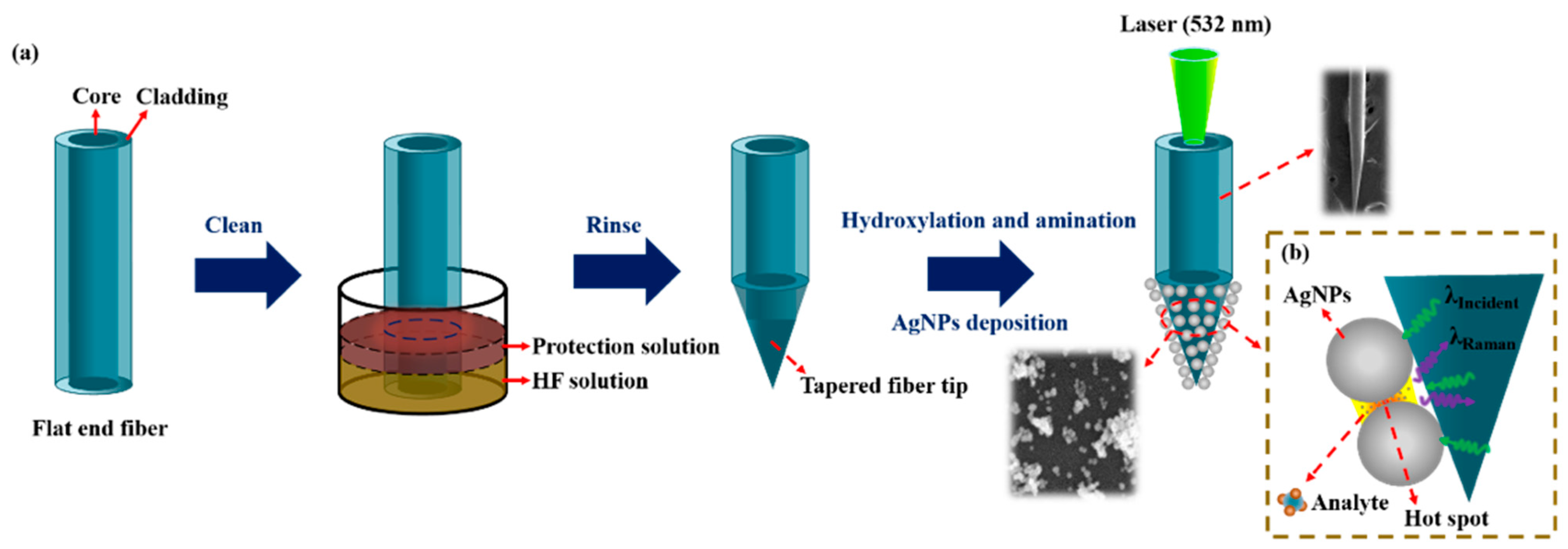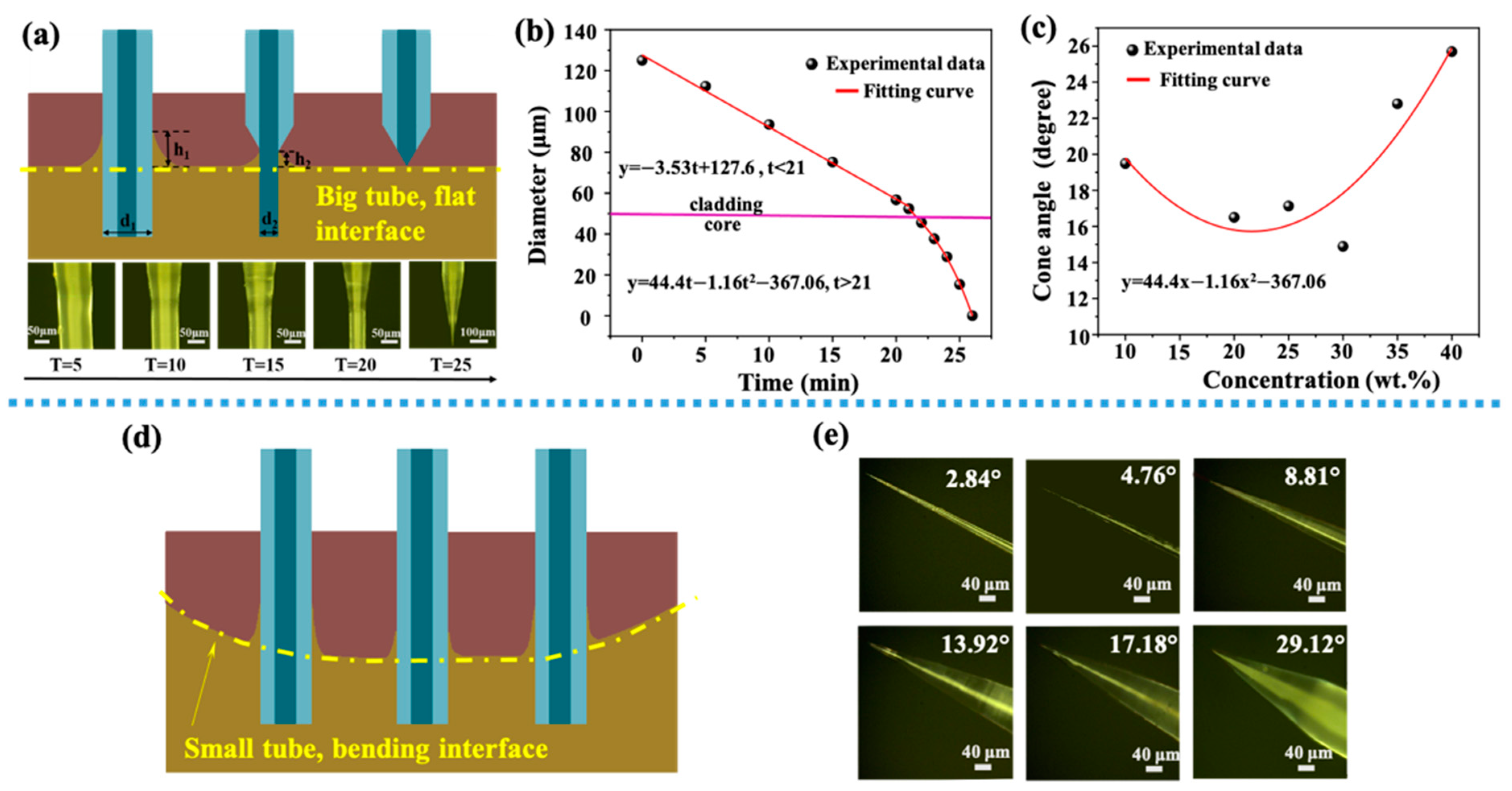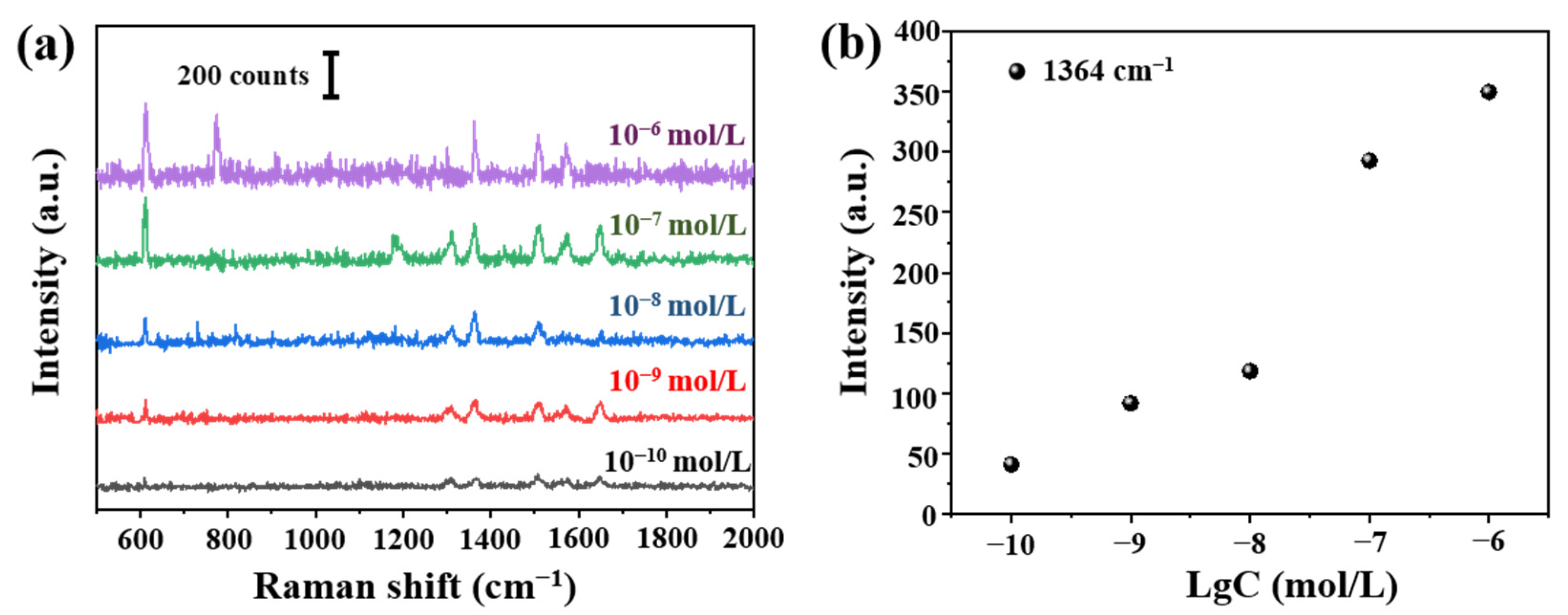Optimized Tapered Fiber Decorated by Ag Nanoparticles for Raman Measurement with High Sensitivity
Abstract
1. Introduction
2. Preparation of the Tapered Fiber SERS (Surface-Eenhanced Raman Scattering) Probe
2.1. Materials
2.2. Preparation Process
2.3. Characterization
3. Experimental Results
3.1. Forming Mechanism of the Tapered Angle
3.2. Coverage Density of AgNPs
3.3. Numerical Analysis
3.4. Time Mapping Experiments
3.5. Performance of the Optimized Fiber SERS (Surface-Enhanced Raman Scattering) Probe
4. Conclusions
Author Contributions
Funding
Institutional Review Board Statement
Informed Consent Statement
Data Availability Statement
Acknowledgments
Conflicts of Interest
References
- McCreery, R.L.; Cooper, J.B. Raman spectroscopy for chemical analysis. Meas. Sci. Technol. 2001, 12, 653. [Google Scholar] [CrossRef]
- Weber, W.H.; Merlin, R. Raman scattering in materials science. Mater. Sci. Forum. 2000, 214, 11–20. [Google Scholar] [CrossRef]
- Saar, B.G.; Freudiger, C.W.; Reichman, J.C.; Stanley, M.; Holtom, G.R.; Xie, X.S. Video-rate molecular imaging in vivo with stimulated Raman scattering. Science 2010, 330, 1368–1370. [Google Scholar] [CrossRef]
- Phyo, J.B.; Woo, A.; Yu, H.J.; Lim, K.M.; Lee, M.Y. Label-Free SERS Analysis of Urine Using a 3D-Stacked AgNW-Glass Fiber Filter Sensor for the Diagnosis of Pancreatic Cancer and Prostate Cancer. Anal. Chem. 2021. [Google Scholar] [CrossRef]
- Shadi, I.T.; Cheung, W.; Goodacre, R. Quantitative analysis of methyl green using surface-enhanced resonance Raman scattering. Anal. Bioanal. Chem. 2009, 394, 1833–1838. [Google Scholar] [CrossRef] [PubMed]
- Kneipp, K.; Yang, W.; Kneipp, H.; Perelman, L.T.; Feld, M.S. Single molecule detection using surface-enhanced Raman scattering (SERS). Phys. Rev. Lett. 1997, 78, 1667. [Google Scholar] [CrossRef]
- Zhang, C.; Dou, X.Y.; Zhang, J.; Zhu, Y. Comparative analysis on Raman enhancement properties of waveguide coupled SERS probe. Opt. Express 2019, 27, 35555–35564. [Google Scholar] [CrossRef]
- Smith, E.; Dent, G. Modern Raman spectroscopy: A practical approach. J. Raman Spectrosc. 2005, 36, 835. [Google Scholar]
- Huang, T.X.; Huang, S.C.; Li, M.H.; Zeng, Z.C.; Wang, X.; Ren, B. Tip-enhanced Raman spectroscopy: Tip-related issues. Anal. Bioanal. Chem. 2015, 407, 8177–8195. [Google Scholar] [CrossRef]
- Fleischmann, M.P.; Hendra, P.J.; Mcquillan, A.J. Raman spectra of pyridine adsorbed at a silver electrode. Chem. Phys. Lett. 1974, 26, 163–166. [Google Scholar] [CrossRef]
- Jeanmaire, D.L.; Duyne, R.P.V. Surface Raman spectroelectrochemistry: Part I. Heterocyclic, aromatic and aliphatic amines adsorbed on the anodized silver electrode. J. Electroanal. Chem. 1977, 84, 1–20. [Google Scholar] [CrossRef]
- Albrecht, M.G.; Creighton, J.A. Anomalously intense Raman spectra of pyridine at a silver electrode. J. Am. Chem. Soc. 1977, 99, 5215–5217. [Google Scholar] [CrossRef]
- Yu, J.; Guo, Y.; Wang, H.J.; Su, S.A.; Zhang, C.; Man, B.Y.; Lei, F. Quasi optical cavity of hierarchical ZnO nanosheets@Ag nanoravines with synergy of near- and far-field effects for in situ Raman detection. J. Phys. Chem. Lett. 2019, 10, 3676–3680. [Google Scholar] [CrossRef] [PubMed]
- Li, C.H.; Xu, S.C.; Yu, J.; Li, Z.; Li, W.F.; Wang, J.H.; Liu, A.; Man, B.Y.; Yang, S.K.; Zhang, C. Local hot charge density regulation: Vibration-free pyroelectric nanogenerator for effectively enhancing catalysis and in-situ surface enhanced Raman scattering monitoring. Nano Energy 2021, 81, 105585. [Google Scholar] [CrossRef]
- Chen, C.Y.; Burstein, E.; Lundquist, S. Giant Raman scattering by pyridine and CN− adsorbed on silver. Solid State Commun. 1979, 32, 63–66. [Google Scholar] [CrossRef]
- Moskovits, M. Surface roughness and the enhanced intensity of Raman scattering by molecules adsorbed on metals. J. Chem. Phys. 1978, 69, 4159. [Google Scholar] [CrossRef]
- Chen, C.Y.; Burstein, E. Giant Raman scattering by molecules at metal-island films. Phys. Rev. Lett. 1980, 45, 1287–1291. [Google Scholar] [CrossRef]
- Chen, J.F.; Li, T.; Zhang, J. Raman enhancement properties of a high uniformity PS microsphere-Ag nanoparticle substrate. Opt. Mater. Express 2020, 10, 3215–3225. [Google Scholar]
- Motz, J.T.; Hunter, M.; Galindo, L.H.; Gardecki, J.A.; Feld, M.S. Optical fiber probe for biomedical Raman spectroscopy. Appl. Opt. 2004, 43, 542–554. [Google Scholar] [CrossRef]
- Huang, J.A.; Zhang, Y.L.; Ding, H.; Sun, H.B. SERS-enabled lab-on-a-chipsystems. Adv. Opt. Mater. 2015, 3, 618–633. [Google Scholar] [CrossRef]
- Kan, X.F.; Yin, C.; Wu, J.; Li, B.W.; Han, Q.B. Tunable Raman scattering enhancement via particle-waveguide coupling. J. Raman Spectrosc. 2019, 50, 908–915. [Google Scholar] [CrossRef]
- Dhakal, A.; Subramanian, A.; Wuytens, P.; Peyskens, F. Evanescent excitation and collection of spontaneous Raman spectra using silicon nitride nanophotonic waveguides. Opt. Lett. 2014, 39, 4025–4028. [Google Scholar] [CrossRef] [PubMed]
- Yin, Z.; Geng, Y.; Xie, Q.; Hong, X.; Tan, X.; Chen, Y.; Wang, L.; Wang, W.; Li, X. Photoreduced silver nanoparticles grown on femtosecond laser ablated D-shaped fiber probe for surface-enhanced Raman scattering. Appl. Opt. 2016, 55, 5408. [Google Scholar] [CrossRef] [PubMed]
- Gu, C.; Zhao, Z.; Shi, P.C. Development of a monolayer AuNPs decorated on optical fiber facet for SERS analysis. Appl. Opt. 2020, 60, 792–798. [Google Scholar] [CrossRef]
- Long, Y.; Li, H.; Du, Z.; Geng, M.M.; Liu, Z.R. Confined Gaussian-distributed electromagnetic field of tin(II) chloride-sensitized surface-enhanced Raman scattering (SERS) optical fiber probe: From localized surface plasmon resonance (LSPR) to waveguide propagation. J. Colloid Interface Sci. 2021, 581 Pt B, 698–708. [Google Scholar] [CrossRef]
- Zhang, J.; Chen, S.M.; Gong, T.C.; Zhang, X.L.; Chen, S.; Zhu, Y. Tapered fiber probe modified by Ag nanoparticles for SERS detection. Plasmonics 2016, 11, 743–751. [Google Scholar] [CrossRef]
- Lee, P.C.; Meisel, D.J.J. Adsorption and surface-enhanced Raman of dyes on silver and god sols. J. Phys. Chem. 1982, 86, 3391–3395. [Google Scholar] [CrossRef]
- Cao, J.; Zhao, D.; Mao, Q.H. Laser-induced synthesis of Ag nanoparticles on the silanized surface of a fiber taper and applications as a SERS probe. RSC Adv. 2015, 5, 99491–99497. [Google Scholar] [CrossRef]
- Puygranier, B.A.F.; Dawson, P. Chemical etching of optical fibre tips experiment and model. Ultramicroscopy 2000, 85, 235–248. [Google Scholar] [CrossRef]
- Ahonen, P.; Laaksonen, T.; Nykänen, A.; Ruokolainen, J. Formation of stable Ag-nanoparticle aggregates induced by dithiol cross-linking. J. Phys. Chem. B 2006, 110, 12954–12958. [Google Scholar] [CrossRef] [PubMed]
- Hutter, T.; Elliott, S.R.; Mahajan, S. Optical fibre-tip probes for SERS: Numerical study for design considerations. Opt. Express 2018, 26, 15539–15550. [Google Scholar] [CrossRef] [PubMed]
- Leru, E.C.; Blackie, E.; Meyer, M.; Etchegoin, P.G. Surface Enhanced Raman Scattering Enhancement Factors: A Comprehensive Study. J. Phys. Chem. C 2007, 111, 13794–13803. [Google Scholar] [CrossRef]
- Zhang, J.; Zhang, X.L.; Lai, C.H.; Zhou, H.J.; Zhu, Y. Silver-decorated aligned CNT arrays as SERS substrates by high temperature annealing. Opt. Express 2014, 22, 21157–21166. [Google Scholar] [CrossRef]
- Mu, Y.; Zhang, X. A Paper-Fiber-Supported 3D SERS Substrate. Plasmonics 2020, 15, 889–896. [Google Scholar] [CrossRef]









Publisher’s Note: MDPI stays neutral with regard to jurisdictional claims in published maps and institutional affiliations. |
© 2021 by the authors. Licensee MDPI, Basel, Switzerland. This article is an open access article distributed under the terms and conditions of the Creative Commons Attribution (CC BY) license (http://creativecommons.org/licenses/by/4.0/).
Share and Cite
Li, T.; Yu, Z.; Wang, Z.; Zhu, Y.; Zhang, J. Optimized Tapered Fiber Decorated by Ag Nanoparticles for Raman Measurement with High Sensitivity. Sensors 2021, 21, 2300. https://doi.org/10.3390/s21072300
Li T, Yu Z, Wang Z, Zhu Y, Zhang J. Optimized Tapered Fiber Decorated by Ag Nanoparticles for Raman Measurement with High Sensitivity. Sensors. 2021; 21(7):2300. https://doi.org/10.3390/s21072300
Chicago/Turabian StyleLi, Tao, Zhinan Yu, Zhengkun Wang, Yong Zhu, and Jie Zhang. 2021. "Optimized Tapered Fiber Decorated by Ag Nanoparticles for Raman Measurement with High Sensitivity" Sensors 21, no. 7: 2300. https://doi.org/10.3390/s21072300
APA StyleLi, T., Yu, Z., Wang, Z., Zhu, Y., & Zhang, J. (2021). Optimized Tapered Fiber Decorated by Ag Nanoparticles for Raman Measurement with High Sensitivity. Sensors, 21(7), 2300. https://doi.org/10.3390/s21072300




